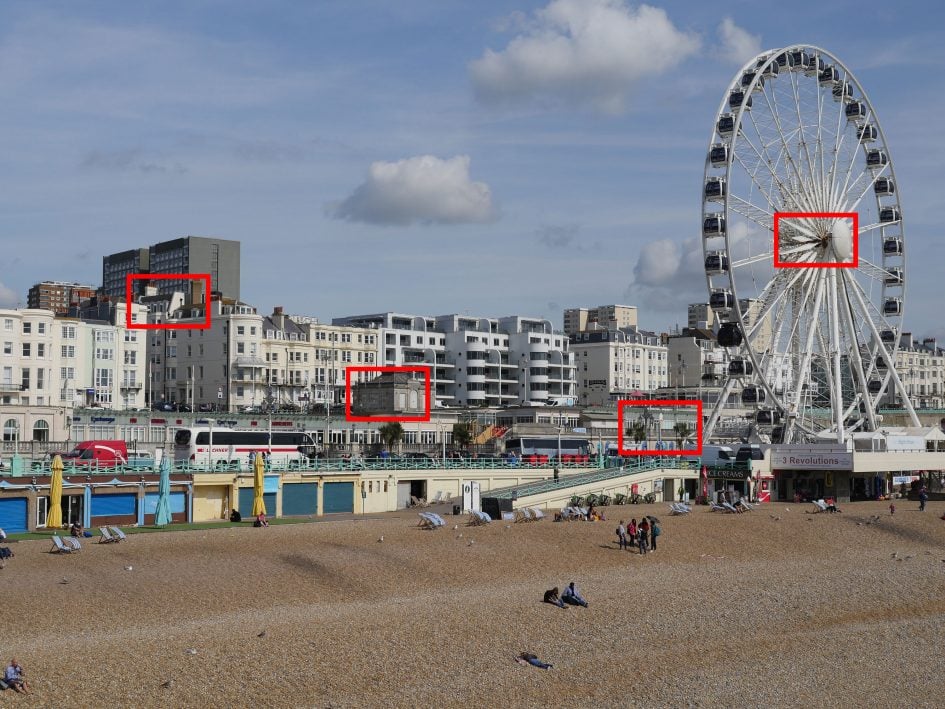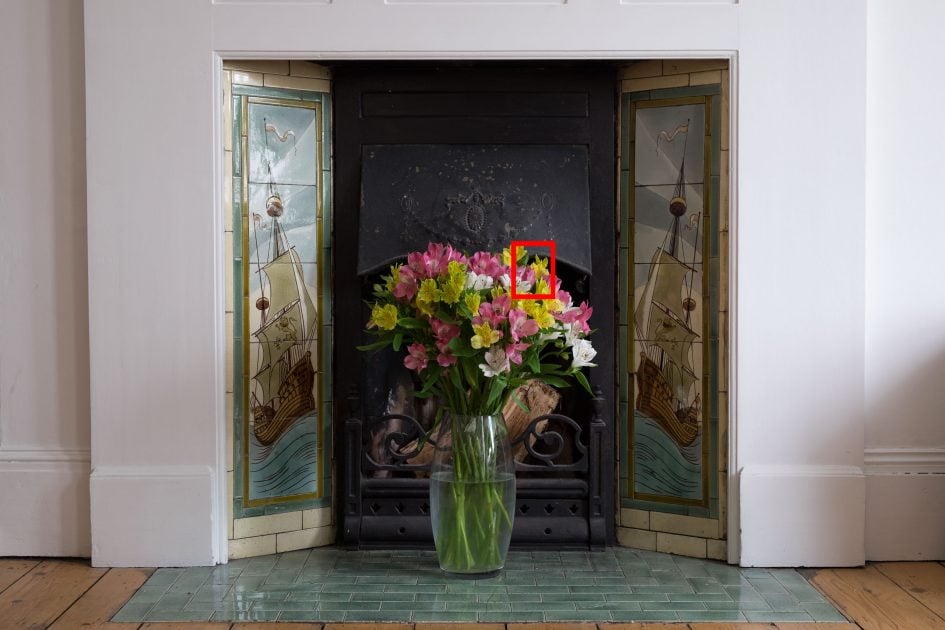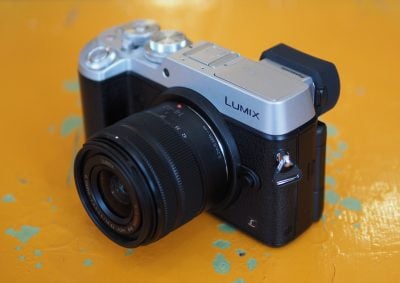Panasonic Lumix GX8 review
-
-
Written by Gordon Laing
Quality
Panasonic’s Lumix GX8 is the first Micro Four Thirds camera to pack more than 16 Megapixels onto its sensor – the new sensor captures 20 Megapixels. The Olympus OMD EM5 Mark II may deliver 40 Megapixel images with its composite mode, but this requires eight images to be captured in a burst before being combined in-camera, and therefore is not ideal if any part of the composition is in motion. So in terms of single frames, the GX8 becomes the highest resolution body in the Micro Four Thirds system, not to mention beating Fujifilm’s X-System which to date remains at 16 Megapixels.
To see how much real-life detail the GX8 can capture over traditional Micro Four Thirds bodies, I tested it alongside the new Olympus OMD EM10 Mark II with both bodies using the same Leica 25mm f1.4 lens closed to f4 for the sharpest results. Both cameras were also set to their base sensitivities of 200 ISO and with their standard picture profiles. I shot the scene in RAW and JPEG and will present the former when the OMD EM10 Mark II is supported in Adobe Camera RAW. In the meantime, here’s the JPEG comparison, and below that I’ve added another table comparing the Fujifilm XT10, OMD EM10 Mark II and Sony A6000 when each is fitted with their standard kit zooms.
The full composition is pictured above and the red rectangles indicate the areas I’ve cropped and presented below at 100% for comparison. With the same lens, both bodies were capturing exactly the same field of view, although the GX8 crops show a slightly smaller area due to its higher resolution.
The first thing to note from the crops below is the slightly punchier processing applied by default on the Olympus when using their standard profiles. As such the OMD EM10 II looks a little sharper and more contrasty than the GX8, but that’s simply image processing which can be adjusted to taste on either model.
In terms of real-life detail, you have to look at the finest patterns to see much difference between the 20 Megapixel GX8 and the 16 Megapixel OMD EM10 II. In the second crop, the grills on the right of the building are resolved on the GX8, but just falling below the resolvable limit of the Olympus. Similarly the writing on the white van in the lower right corner of the third crops is better-resolved on the GX8, as are some of the details of the Ferris Wheel.
As with so many resolution comparisons though, the differences can be subtle to say the least, and in some instances you may not see them at all. Suffice it to say you’ll also need to shoot carefully with your sharpest lenses to spot any differences. But the fact remains the GX8 is capable of out-resolving 16 Megapixel Micro Four Thirds bodies and for that some will thank Panasonic for pushing the format. Scroll down and you’ll see if it has a negative impact on noise levels in low light at high sensitivities, or you could skip to my Lumix GX8 sample images or head back to my verdict.
Above left: Lumix GX8, above right: OMD EM10 II. Both with Lumix 25mm at f4. 100% crops from JPEGs
Above left: Lumix GX8, above right: OMD EM10 II. Both with Lumix 25mm at f4. 100% crops from JPEGs
Above left: Lumix GX8, above right: OMD EM10 II. Both with Lumix 25mm at f4. 100% crops from JPEGs
Above left: Lumix GX8, above right: OMD EM10 II. Both with Lumix 25mm at f4. 100% crops from JPEGs
Panasonic Lumix GX8 noise
To compare noise levels in low light I photographed this scene with each camera using their full range of ISO sensitivities. Each camera was fitted with its respective kit zoom, adjusted to deliver the same vertical field of view and set to an aperture for optimal sharpness. Each camera was using its default processing style with the only modification being a disabling of tonal optimisation as these can accentuate noise. All four cameras metered the same exposures, so what you’re looking at below is directly comparable. The full view is shown below with the red rectangle indicating the cropped area, presented below at 100%.
In the first table I’ve compared JPEGs out-of-camera without modification. In the second table I’ve compared RAW files, all processed in Adobe Camera RAW using the same sharpening settings (50 / 0.5 / 36 / 10) and with all noise reduction disabled; note the RAW results from the Olympus OMD EM10 Mark II are missing until it’s supported by Adobe Camera RAW.
In the tables below from left to right you’ll see the Fujifilm XT10, Olympus OMD EM10 Mark II, Panasonic Lumix GX8 and Sony Alpha A6000; these offer resolutions of 16, 16, 20 and 24 Megapixels respectively, so as the resolution increases, the cropped area reduces in coverage. The sensor in the XT10 is the same as the XT1, so its results are effectively interchangeable. Likewise for the OMD EM10 Mark II and the OMD EM5 Mark II. So if you’re comparing the Lumix GX8 against these higher-end models, the results here are applicable.
Starting with the JPEG comparison, the first thing you’ll notice is how the Olympus OMD EM10 Mark II crops looks punchier than the others. This is down to the default image processing on the Olympus cameras which applies above average sharpening and contrast for a more vivid appearance – remember this is just a default style and it’s possible to tone it down, or indeed make the others punchier if desired. But equally if you like the vibrant style and want the minimum effort, the Olympus cameras give it you by default.
Between 100 and 400 ISO, all four cameras are delivering clean and detailed results that can stand-up to a high degree of sharpening if desired. At 800 ISO, the Lumix GX8 and Sony A6000 begin to show the faintest smattering of noise textures, an effect that becomes more obvious at 1600 ISO. At this point the Panasonic GX8 takes a more hands-off approach to noise reduction, allowing the detail to remain at the cost of increased noise textures. In contrast the Sony is quite noise-averse, attempting to iron-out any speckles with increased smearing and loss of fine detail.
Meanwhile the Olympus OMD EM10 Mark II is managing to tackle noise without too much smearing, while the larger sensor of the Fuji XT10 coupled with its low resolution means noise doesn’t become an issue until higher sensitivities.
At 3200 ISO, all four cameras are having to deal with ever-higher noise levels, with the Sony A6000 trying the hardest to eliminate them, but at the cost of ever-aggressive smudging. I’d say for image quality out-the-box, it’s the least good-looking of the foursome, proving that having the highest resolution isn’t necessarily the best choice. Meanwhile the Lumix GX8, with the second highest resolution here (and a smaller sensor than the Sony or Fuji) unsurprisingly suffers from noise sooner than those with bigger sensors or lower resolutions.
I’d say the Olympus OMD EM10 Mark II and Fujifilm XT10 are delivering the best overall images here, the Fuji thanks to its APS-C sized sensor and relatively low resolution, and the Olympus for its processing making the most of its sensor real estate.
But this is when they’re judged on out-of-camera JPEGs using the default settings. In the second table you can see how the RAW data compares. Scroll down to see this.
Above left to right: Fuji XT10, OMD EM10 II, Lumix GX8, Sony A6000. All 100% crops from JPEGs at 100 ISO
Above left to right: Fuji XT10, OMD EM10 II, Lumix GX8, Sony A6000. All 100% crops from JPEGs at 200 ISO
Above left to right: Fuji XT10, OMD EM10 II, Lumix GX8, Sony A6000. All 100% crops from JPEGs at 400 ISO
Above left to right: Fuji XT10, OMD EM10 II, Lumix GX8, Sony A6000. All 100% crops from JPEGs at 800 ISO
Above left to right: Fuji XT10, OMD EM10 II, Lumix GX8, Sony A6000. All 100% crops from JPEGs at 1600 ISO
Above left to right: Fuji XT10, OMD EM10 II, Lumix GX8, Sony A6000. All 100% crops from JPEGs at 3200 ISO
Above left to right: Fuji XT10, OMD EM10 II, Lumix GX8, Sony A6000. All 100% crops from JPEGs at 6400 ISO
Above left to right: Fuji XT10, OMD EM10 II, Lumix GX8, Sony A6000. All 100% crops from JPEGs at 12800 ISO
Above left to right: Fuji XT10, OMD EM10 II, Lumix GX8, Sony A6000. All 100% crops from JPEGs at 25600 ISO
Above left to right: Fuji XT10, OMD EM10 II, Lumix GX8, Sony A6000. All 100% crops from JPEGs at 51200 ISO
Fujifilm XT10 vs OMD EM10 II vs Lumix GX8 vs Sony A6000 RAW noise
In the table below you can see RAW output from the Fujifilm XT10, Olympus OMD EM10 Mark II, Panasonic Lumix GX8 and Sony Alpha A6000; these offer resolutions of 16, 16, 20 and 24 Megapixels respectively, so as the resolution increases, the cropped area reduces in coverage. The sensor in the XT10 is the same as the XT1, so its results are effectively interchangeable. Likewise for the OMD EM10 Mark II and the OMD EM5 Mark II. So if you’re comparing the Lumix GX8 against these higher-end models, the results here are applicable. Note at the time of writing, the Olympus OMD EM10 Mark II’s RAW files were not supported by Adobe Camera RAW; once supported I’ll add its results to the table.
All the RAW files were processed in Adobe Camera RAW using the same settings: a high degree of sharpening (50 / 0.5 / 36 / 10) and zero noise reduction. These settings were chosen to reveal the differences in sensor quality and isolate them from in-camera processing. The high degree of sharpening with a small radius enhances the finest details without causing undesirable artefacts, while the zero noise reduction unveils what’s really going on behind the scenes – as such the visible noise levels at higher ISOs will be much greater than you’re used to seeing in many comparisons, but again it’s an approach that’s designed to show the actual detail that’s being recorded before you start work on processing and cleaning it up if desired. All four cameras metered the same exposures, so what you’re looking at below is directly comparable in every respect.
The Fujifilm XT10, Lumix GX8 and Sony A6000 start off their ISO ranges with similarly clean results, but before long differences emerge. As you’d expect, the Lumix GX8 and Sony A6000 start to exhibit noise speckles sooner rather than later thanks to packing the most pixels into their sensor areas. The Sony sensor is a little larger, but then it has 4 more Megapixels too, so they’re both pushing it. That said, I’d say the Lumix GX8 enjoys slightly lower noise levels than the Sony A6000 towards the upper-end of their sensitivities.
Meanwhile, again as you’d expect, the Fujifilm XT10 with its APS-C sized sensor and relatively low resolution, manages to keep noise under control much better – just compare it with the other cameras at 1600 to 6400 ISO and you’ll see while there is obviously some noise, it’s much lower than the others.
Revealingly, I’d say the Fuji also matches the recorded detail of the higher resolution models as the sensitivity increases, proving again that more Megapixels isn’t always the way to superior image quality. High resolutions only really deliver superior results at the lowest sensitivities and when coupled with a high quality lens. Fit kit zooms or shoot at high ISOs and any potential benefit is lost.
While Panasonic has just about got away with its boost to 20 Megapixels, I’d have preferred them to stay at 16 and concentrate on either making the sensor technology more efficient or integrating some kind of phase-detect AF system. Certainly while there is a minor boost in resolving power at low sensitivities, I don’t think it’s hugely compelling. I hope Fuji isn’t tempted to increase resolutions just to compete in a numbers game.
Above left to right: Fuji XT10, OMD EM10 II, Lumix GX8, Sony A6000. All 100% crops from RAWs at 100 ISO
Above left to right: Fuji XT10, OMD EM10 II, Lumix GX8, Sony A6000. All 100% crops from RAWs at 200 ISO
Above left to right: Fuji XT10, OMD EM10 II, Lumix GX8, Sony A6000. All 100% crops from RAWs at 400 ISO
Above left to right: Fuji XT10, OMD EM10 II, Lumix GX8, Sony A6000. All 100% crops from RAWs at 800 ISO
Above left to right: Fuji XT10, OMD EM10 II, Lumix GX8, Sony A6000. All 100% crops from RAWs at 1600 ISO
Above left to right: Fuji XT10, OMD EM10 II, Lumix GX8, Sony A6000. All 100% crops from RAWs at 3200 ISO
Above left to right: Fuji XT10, OMD EM10 II, Lumix GX8, Sony A6000. All 100% crops from RAWs at 6400 ISO
Above left to right: Fuji XT10, OMD EM10 II, Lumix GX8, Sony A6000. All 100% crops from RAWs at 12800 ISO
Above left to right: Fuji XT10, OMD EM10 II, Lumix GX8, Sony A6000. All 100% crops from RAWs at 25600 ISO
Next check out my sample images or skip straight to my verdict.





























